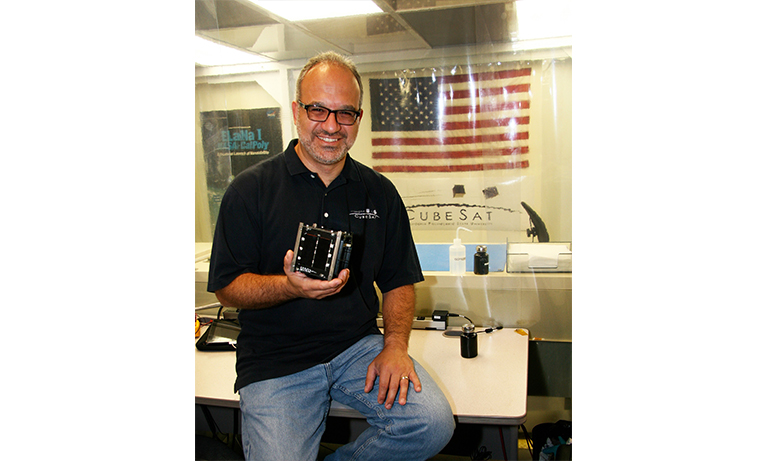When he gazes at the night sky from his 50-foot sailboat, Jordi Puig-Suari will see spectacular displays of moon and stars. But, he knows, there’s more up there – unseen by the naked eye.
“I’m really happy that there are satellites up there that help me navigate,” he said. “GPS and all that. I’m very conscious of the stuff that’s up there that I’m using all the time.”
Having co-created CubeSat technology, satellites are a major part of Puig-Suari’s legacy at Cal Poly. But while his work made him a respected pioneer in aerospace research, Puig-Suari retired early so he could explore the planet in a different way.
“We’re starting to hear friends who are older saying, ‘Oh, my back is bugging me’ or ‘My knee is doing this,’ ” Puig-Suari said. “And it’s like, ‘How much longer will we be in a position to do this?’ So we’re sort of retiring in the middle instead of retiring at the end because we want to be good enough to do this for a few years.”
Puig-Suari is traveling the world with his wife and 15-year-old son. He and his family will launch their boat, Lola, from the Mediterranean Sea. From there, they will cross the Atlantic, then pass through the Panama Canal to reach the Pacific, headed toward the Indian Ocean. On the final leg, they will sail around South Africa to reach their final destination, the Caribbean.
But they plan to be flexible, stopping several times, especially if bad weather is in the forecast.
“The worst thing you can do is have a schedule,” he said. “Because then you make bad decisions. That’s one reason to retire — we want to do it and not have any pressure.”
While Puig-Suari is focused on the epic journey ahead, he is best known for creating a path to space for students, private companies and government agencies worldwide. But as a child growing up in Barcelona, Spain, he hadn’t even considered a career in aerospace.
“Where I grew up that wasn’t even something you thought about,” he said. “You’d see airplanes at the airport, but space was, like — NASA does that kind of stuff. And they’re all rocket scientists.”
He went to Purdue University, known producing astronauts. And in 1998, he landed at Cal Poly, teaching aerospace engineering.
While at Cal Poly, he teamed with then-Stanford professor Bob Twiggs to develop the CubeSat standard. Their idea was simple: Create small satellites (4-inch cubes) and capsules that could hitch a ride as secondary payloads aboard government and commercial space launches.

Cal Poly’s Jordi Puig-Suari gives Major General Stephen Whiting, Vandenberg Air Force Base commander, a tour of the CubeSat Lab.
While others had considered the idea of mini-satellites, Puig-Suari said, no one had pursued it.
“The industry was in low-risk tolerance mode,” he said. “You couldn’t build things that failed.”
He and Twiggs didn’t have many expectations for the CubeSats — other than affording students an opportunity to launch things into space.
“It was purely an educational activity, so a lot of people said, ‘You’re not going to do anything with these — they’re stupid.’” he said. “They were toys that could do no science.”
Yet, that’s what made it so easy to forge ahead. With no funding from companies, they didn’t have to cater to anyone’s demands. “We were going to teach students — that’s all we cared about. So we were going forward with no risks, and people didn’t get that.”
Fortunately, he said, the timing was right — sophisticated technology was coming in smaller packages, like cellphones. So Cal Poly students did create meaningful satellites. They also built the technology that could deploy satellites created by other universities.
Initially, they couldn’t find American companies to help them launch the satellites, so they turned to Russia, where they could launch for $40,000 per cube. For the initial launch, a dozen other universities joined Cal Poly.
Unfortunately, the Russian rocket crashed.
“Which was very disappointing,” Puig-Suari said. “But it had a tremendous PR impact because all these people said, ‘Why are the universities going to Russia to launch satellites? We can launch them.’ Everybody kind of saw it as an embarrassment that we were going to Russia.”

Jori Puig-Suari, who pioneered the CubeSat program at Cal Poly, retired early so he could sail around the world with his wife and 15-year-old son.
Soon, Cal Poly was leading launches in America – first for itself and other universities, then for corporations and government agencies.
“Cal Poly played a key role in making sure these things launched,” Puig-Suari said. “For a long time, we were the only game in town as far as putting things in space.”
Eventually, even high schools – and, in some cases, middle schools – were launching mini-satellites into space.
In all, Puig-Suari was involved in grants totaling over $20 million. And when he looks into space from his sailboat, he can think about the 2,000 CubeSats that have been launched since he and Twiggs created the CubeSat standard. That includes CubeSats NASA launched in May on a mission to Mars.
“We were out in left field,” he said. “Crazy ideas become brilliant when they work. But you need to try it and see if they work.”
Failure is an important part of the discovery process, he said. But not something you want to encounter on a sailing adventure.
Luckily, he’ll use technology created by others to avoid setbacks.
“You can get weather info and know when things are good or bad,” he said. “And, basically, you can dial in the amount of adventure you want. We’re in the Small Adventure category.”


